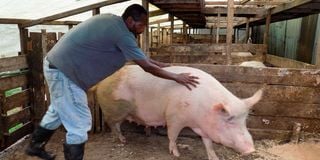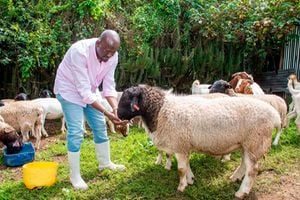
Kenneth Orwaya tends to a paig at his farm in Huruma, Nairobi.
Back in 2021, I visited a site Mary wanted to revive her pig farm. She had started the project without proper planning, encountering many operational challenges.
By the time she closed the farm, due to a national road redevelopment project, Mary had not associated her problems with the initial poor design of the farm. The problems included illnesses in her animals, injuries and external parasites.
When I visited the site, Mary was ready to restart because the road project was almost complete and the farm was now accessible.
I reviewed the farm and, together with Mary and her partner, we came up with a properly thought out design and initial stocking programme.
We visited a farm in Gatundu that, fortunately, supplied Mary with the 36 pregnant gilts she needed over six months.
The gilts were supplied when two months pregnant in groups of six.
I was happy to call Mary two weeks ago and confirm that she was still happy with her pig farm.
Mary told me she was even preparing to move some of the pigs to a bigger farm in Kiambu County. It was encouraging that her plan had worked.
From the outset, I had made it clear that the revived farm could only comfortably hold about 400 pigs at any one time and Mary would need to relocate the farm to a bigger area or establish a branch.
At the time I called Mary recently, her farm was congested with 650 pigs.
It was good Mary acknowledged the congestion, which she said had been caused by some pigs that had grown slower than expected.
She would sell them off in a week and get back close to her comfortable number of about 500. She had squeezed in some more space from the original design to exceed the projection of 400.
I had called Mary to request her to incubate Kimani, an aspiring pig farmer. He has never reared pigs but has passion for the venture.
When I met Kimani about five weeks ago, he impressed me with an elaborate plan to first understand pig farming before delving into the agribusiness.
Being an accountant, he said he would not take chances with ignorance.
I encourage prospective pig farmers to do the same. Even farmers who have no structured knowledge of farming should seek to educate themselves regarding the type of farming they do.
That way, they work from a position of knowledge and have better chances of making their business profitable.
Mary agreed to incubate Kimani and was happy to meet another farmer with similar ideas as her regarding pig farming.
By the time I met Kimani, he had attended some training with a major pork producer and processor.
He now required to visit some active and good keepers to understand issues of practical pig farming, see how they have organised their farms and understand how they manage feed acquisition or processing.
In addition to Mary, I organised for Kimani to visit two other pig farmers who, thankfully, had agreed to host him.
One of them said he could organise with Kimani and supply him weaner piglets and pregnant gilts to start off his farm when he was ready with the construction, staff and other operational requirements.
I visited Kimani’s proposed farm site three weeks ago to advise on siting of the pig houses and other operational requirements.
Kimani aims to sell 50 baconers every month.
That means he would need to have at least 36 sows or mother pigs grouped into units of six sows that give birth within one week of each other or thereabouts.
I observed that Kimani’s land in Kiambu was fit for pig farming and its location would not be a nuisance to locals if the farm were properly managed.
Pig farming can be a public health and environmental nuisance if feeding, housing and waste management is not handled well.
Farms which use hotel waste as food tend to have noxious odour where neighbours complain and may cause the farm to be shifted or shut down by health authorities.
When commercial feeds and proper waste management are practised, the farm is almost odourless.
I recall a farm I rescued in Kahawa West that had been ordered shut by authorities due to emitting bad odour and breeding numerous types of flies.
When I visited the farm, the two workers there told me they only had breakfast because their stomachs got fouled up by the smell during the day.
I advised on thorough cleaning and immediate shift from hotel waste to commercial feed.
I also requested the health authorities to give the farmer two weeks to clean up the place and eliminate the odour, flies and manure pollution.
They agreed and said they would inspect the farm after two weeks if reports of the nuisance, from the residents of the area, declined within the period.
The woman had 200 pigs and they were her only source of livelihood.
I went back to the farm after two weeks and found the workers having lunch. The place had no smell and no flies. The pigs and their pens were clean.
Back to Kimani’s farm site, I noticed half the land was suitable for putting up pig houses without too much levelling.
The other half was steep and not suitable for putting up sties. The land had a river at the bottom of a valley.
I advised good containment of the proposed piggery’s effluent to prevent pollution of the river. I also noted there was a borehole on the land but next to a pit latrine.
I advised the latrine be moved to avoid contamination of the ground water with faecal material or faecal bacteria.
With the information I collected from Kimani’s land, I will be able to advise him on the best way to set up his farm. I get excited to see people move from low or no agriculture knowledge to accomplished livestock farmers.









